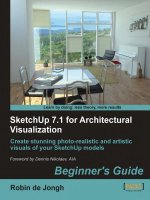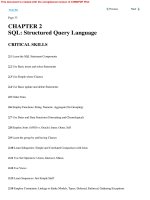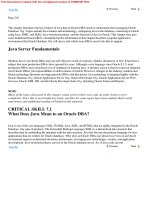SketchUp 7.1 for Architectural Visualization Beginner''''s Guide phần 2 ppt
Bạn đang xem bản rút gọn của tài liệu. Xem và tải ngay bản đầy đủ của tài liệu tại đây (1.3 MB, 41 trang )
Chapter 1
[ 21 ]
12. Rotate and pan to the opposite corner, nd the midpoint and click again.
13. Select this rectangle and give it a glass material with the Paint Bucket.
14. If any wall faces have turned blue, select them now. Right-click and select
Reverse Faces.
Here's the nished window:
Photo images
You're bound to have some images that will do as a backdrop for your scene. If not, just grab
something from the Internet for now. All you're aer is a fairly interesng view out of the
window. You'll need some pictures that will do for the gallery painngs too. In Chapters 3
and 5 you'll look at where to nd great images to use in your scenes from the Internet, and
how to make the best use of them to set up your scenes.
Quick Start Tutorial
[ 22 ]
Time for action – setting up the scenery backdrop
1. Go to File | Import, and ck the Use As Image box. Navigate to an image,
click on it and click Open.
2. Zoom out in your model and click somewhere on the window to insert the image.
Drag the cursor to size it and click again.
3. You have now inserted the image in the correct plane—the plane of the window.
4. Use Move to set it further from the window and alter the height posion (see the
following screenshot). Click on the scene tab at any me to check what you
will see out of the window.
Chapter 1
[ 23 ]
5. Use the Move funcon and hover over the edge of the image. You will see some red
plus signs appear. Use these to rotate the backdrop if you need to alter the angle
(see the following screenshot).
6. Explode the image (right-click and select, Explode)
7. Right-click on the image and select Enty Info
8. Unck Cast Shadows and Receive Shadows
Time for action – hanging digital art
For the artwork on the wall you can simply grab some images of your own or browse the
web. It doesn't maer for this tutorial where you get them from. But if you have some art
of your own, why not scan or photograph it and use it here? You can create your own
3D porolio!
Quick Start Tutorial
[ 24 ]
1. Go to File | Import. Now move the cursor to the wall and click. Stretch the image to
the size you want and click again.
2. Repeat this for more images. Remember to click on the scene tab from me to
me so that you can see what will or won't be in the frame when you render.
3. Now right-click on each image and select Explode (see the following screenshot)
4. When you're done, use the Push/Pull tool to give the canvasses some depth.
Chapter 1
[ 25 ]
5. Finally, close the side of the room back up. Go to View | Hidden Geometry
6. Select the hidden wall. Right-click and select Unhide.
7. Click the scene tab to check the camera posion. You should have something
like this image:
Quick Start Tutorial
[ 26 ]
Exporting to the render application
Install Kerkythea, the free rendering soware which you will nd on the website www.
kerkythea.net
. You'll also need to install the free SketchUp to Kerkythea exporter
(SU2KT), which you'll also nd on the website. Details about this and loads of other items
up for grabs are in Chapter 2.
1. In SketchUp, go to View | Toolbars and make sure SU2Kerkythea is cked.
2. Click the Export model to Kerkythea buon. You'll get the dialog box shown
in the following screenshot:
3. Change Export opons to Yes for Geometry and Lights.
4. Click OK. Find a folder to save the le to and type in a le name, then click Save.
5. When asked Open exported Model in Kerkythea? click No for now.
6. Open Kerkythea and go to File | Open. Find your saved le, click on it and click OK.
7. The following screenshot shows what you should be presented with. All the buons
are explained in Chapter 8 but you can sll produce a great render knowing no more
about them than you learn in this Quickstart. That's because SketchUp has taken
care of most things already.
Chapter 1
[ 27 ]
8. Hit V on the keyboard to view the scene in solid colors.
Modifying materials in Kerkythea quickly
If you were to render this scene straight away you would get something like the
following screenshot:
Quick Start Tutorial
[ 28 ]
This is rather nice, but there are a few things missing. Noce what sll needs to be done
for a realisc scene:
The glass material needs reecons
The smooth oor needs to be shiny
The lights need to go on
But that's all you need to do. Kerkythea's lighng and shadows already make for a
pleasingly realisc scene. Follow these steps now to add in these last few details.
Time for action – Kerkythea materials
1. Click on the glass window. A star appears in the list to the le, next to the name
of the glass material you used in SketchUp.
2. Right-click this and select Apply Materials | Basic Pack | Thin Glass. This comes
already installed with Kerkythea.
Chapter 1
[ 29 ]
Diffused light
This is the easiest step of all, and it makes seng up photo-realisc scenes with indoor
lighng child's play.
3. Click on the color you selected in SketchUp for the ceiling lights.
4. Right-click and select Apply Materials | Basic Pack | Diuse Light.
Reective oors
5. Select the oor material.
6. Right-click and select Edit Material. This takes you to the Material Editor.
7. Right-click on Reecon and click the le buon (shown in the previous screenshot).
8. Drag the cursor down the right-hand side of the triangle to select a dark grey
(see the following screenshot). Click Accept.
Quick Start Tutorial
[ 30 ]
9. You can alter these grey levels unl you're happy with the preview image
shown top le in the material editor. A dark grey is usually best.
10. Click Apply Changes, then Close Editor.
What just happened?
What you've just done is added qualies to your SketchUp materials that they didn't possess
before. And usually these few steps are all that's needed to get a great render. It's really
simple and really eecve. The grey levels are Kerkythea's way of obtaining a value. It
helps to think of it as a slider or volume control on your stereo: black is none, and white is
maximum. You don't need to bother with the other colors in the triangle.
Rendering in Kerkythea
Now you're all set. If you've followed all the steps so far, the nished render is just a few
clicks away!
1. Select the lile green buon (Start Render).
2. Select the preset seng labeled 07. PhotonMap – High + AA 0.3.
3. Leave everything else as it is and hit Ok.
4. The render will progress and appear in the boom right preview window.
Chapter 1
[ 31 ]
5. At the top le corner of your screen you will see a percentage complete status.
When it's nished click the Image buon.
6. The image preview window appears. Click Save, type in a le name and click OK.
Here's your nished render:
Quick Start Tutorial
[ 32 ]
Summary
This chapter was designed to give you a taste of how easily and quickly you can get great
photo-realisc results with the SketchUp and Kerkythea combinaon. In parcular, you've
learned the basic steps towards:
Modeling a simple indoor studio scene
Seng up daylight and indoor lighng
Applying photo backgrounds to add realism
Enhancing SketchUp materials in Kerkythea for photo-realisc rendering
This is the basic framework for achieving successful renders of most interior and outdoor
scenes. Congratulaons! You're now able to apply what you've learned immediately in
your own projects. The rest of the chapters in this book will take your skills a step or two
further. You can dip in whenever you need some specic guidance, or follow the chapters
in a course format.
In the next chapter, you'll nd out how to create your own visualizaon and animaon
studio setup with free soware and plugins, ready to make even beer architectural visuals!
2
How to Collect an Arsenal Rambo
Would Be Proud of
Have you ever watched an acon movie and been moved to tears of joy when
the would-be acon hero suddenly stumbles upon a stash of armaments t
to kit out a private army? There's a rack of M60 machine guns on that barn
wall; sixty boxes of ammo over there by the bale of hay; a table of handguns
of every imaginable make, shape, and size neatly arranged over by the door;
and to nish o the scene, there's always a special prize—the rocket launcher
that turns weeny Wodger into a one man army. Cut to a scene outside the
building: he appears through the door laden with his bounty; a smoldering
cigar in his mouth.
Well, that's how you're going to feel in a minute!
In this chapter you will:
Turbo charge your copy of SketchUp with terrain tools
Set up your post-processing studio with GIMP
Be given free access to the best rendering technology available
Install some secret buons that virtually turn SketchUp into 3D Max
Witness how SketchUp and Google Earth work in tandem
Set up an animaon producon studio
How to Collect an Arsenal Rambo Would Be Proud of
[ 34 ]
If it's not free, it's not worth having
Let's get one thing straight right now. This arsenal you're going to go get yourself is just lying
around for free. No one ever expects the acon hero to pay for it, so neither should you. In
fact, if it's not free, don't bother with it. This book will show you how to create great looking
architectural visuals for nothing. One of the reasons we're going to use free soware is that
it's somemes beer than the bought stu. But that's not all; the most important thing is
psychology. Let me explain.
Don't be beholden to your software
There's a subtle but very, very important psychological reason you should try free soware.
The reason is that the more you pay for soware, the more you will feel compelled to use
that soware, rather than something beer. This is suicide, because some other soware
is always being released beer than what you've got already. And if you haven't bought
any soware yet, you end up spending all your me trying out, evaluang, and poring over
product reviews rather than geng on with creang great visuals. With free stu you just
download it and launch right in.
So, don't be beholden to your soware, or in other words, don't let it se your creavity.
If you buy expensive soware you will always be pressured to adopt the work-stream they
have prepared for you. And that work-stream usually involves buying more add-on funcons.
Free soware oen lets you use it however you want to, without needing to buy more
funconality to what you need it to do; in other words, in the most producve and eecve
way. With this book, we will discover what that is for creang architectural visuals.
How is free software so good?
Free soware is so good because lots of people with lots of spare me contribute to it.
Computer programmers, by and large, respond well to only two movators:
Respect
Cheeseburgers
So, coding Blender or Kerkythea for free doesn't maer to them, as long as they can do it
in their own bedroom surrounded by cheeseburger wrappers and get some credit for it.
Remember, these guys might spend 8 hours of the day earning a living, 7 hours sleeping,
leaving them 7.5 hours to create your arsenal of weaponry. (You don't want to know about
the other 1.5 hours.)
Chapter 2
[ 35 ]
Google software
Let's start with Google itself. Google SketchUp is free as long as you're not too bothered
about imporng/exporng CAD formats. Almost all of the tutorials in this book can be done,
free of cost, with SketchUp. Once you have SketchUp (the free or the Pro version) installed,
take a look at the other Google goodies that follow.
Google's component bonus packs
Google used to provide loads of great components readily available in their bonus packs.
However, you now have to search and download them as and when you need to, using 3D
Warehouse. Thankfully, there are opons to save them all to your computer so you don't
have to go online for them every me.
Time for action – restoring the collection to its rightful place
If you used SketchUp version 6 before you upgraded to version 7, you can import the
component collecons as follows:
1. In SketchUp 7, select Window | Components.
2. Make sure you're in the Select tab.
3. Click the details buon to the right of the search box.
4. Select Open or create a local collecon
5. Browse to C:\Program Files\Google\Google SketchUp 6\ and
select the desired folder.
6. Click OK.
7. Click the details buon.
8. Select Add to favorites so you can access the collecon again.
Saving collecons from the web if you don't have SketchUp 6:
9. Select Window | Components.
10. Click the Select tab and then click the lile arrow next to the house icon.
11. Select a Bonus Pack category (such as Architecture).
12. Within this collecon, scroll to a sub-collecon and click.
How to Collect an Arsenal Rambo Would Be Proud of
[ 36 ]
13. Click the Details buon then click Save as a local collecon.
14. Navigate to the folder where you'd like to save the models.
15. Click OK.
16. Now click the Details buon again.
17. Select Add to favorites so you can access the collecon again.
18. Repeat this for any other collecons you want to access o-line.
What just happened?
If you don't have SketchUp 6, you can sll save the results of a component search locally
to your computer. Using this method you can eventually nd and download all the bonus
pack collecons. You can also input a special search string into the search box to only look
for collecons, not individual components. Just type in is:collecon with your search. For
example, lm stage is:collecon.
The main collecons you should look for include:
Construcon
Film and Stage
Architecture
Landscape Architecture
Mechanical
2D People
Transportaon
Shapes
Chapter 2
[ 37 ]
Google Earth
Believe it or not, SketchUp is joined at the hip with Google Earth. Didn't know that? I thought
you'd be surprised. Just over a year before Google bought @last soware, the makers of
SketchUp, it also bought Keyhole Corp, the makers of Google Earth. Both Google Earth and
SketchUp were then released for free. The development of the two technologies became
inextricably linked, with SketchUp models being able to be viewed in Google Earth, and
Google Earth terrain in SketchUp.
Geo location toolbars
Within the standard free version of SketchUp there are buons which allow you to geo-
reference your model in Google Earth; it's very easy to do and lots of fun. The buons here
can be used to import to SketchUp or export to Google Earth at a single click.
Within SketchUp just click the following to bring up the toolbar:
View | Toolbars | Google
Why do I need Google Earth?
Google Earth is really just an extension of SketchUp. Think of it as SketchUp on the web.
Given that Google have also now released their own web browser—Chrome, it's a prey
good guess that the internet will go 3D in a big way some me in the future. The connual
increase in the compung power available in a standard desktop computer, and the
proliferaon of fast broadband connecons means that soon the average consumer could be
exploring the world online enrely in a 3D browser!
What this really means to you as an architectural visualizaon creator is that the massive
eort Google is pung into the Google Earth-Internet-SketchUp combo can be used to great
eect when visualizing your buildings in their real world seng. You'll nd out all about this
in Chapter 5, Applying Textures and Materials.
To get Google Earth visit
How to Collect an Arsenal Rambo Would Be Proud of
[ 38 ]
Once you've installed Google Earth it will automacally work with SketchUp. You can now
import terrain into SketchUp using the menu buons on the Google Toolbar. You can also
export geo-referenced models into Google Earth.
SketchUp Pro, LayOut, and Style Builder
Although SketchUp Pro and the tools that come with it (LayOut and Style Builder) are not
free, I'll give them a menon because a lot of you will already have, or be thinking of owning
SketchUp Pro. LayOut is a stand-alone program and is explained more fully in Chapter 11,
Presenng Visuals in Layout. With Layout you can easily import your SketchUp models and
create presentaon pages for print or onscreen rather like PowerPoint or Keynote.
SketchUp Pro enables you to import and export CAD data, which is a must when using
SketchUp within a professional work-ow. You also gain the privilege of creang dynamic
components, which work a lile like Dynamic Blocks in AutoCAD.
Additional import formats with SketchUp Pro
AutoCAD (.dwg, .dxf)
Additional export formats with SketchUp Pro
2D Formats:
Portable Document Format (.pdf)
Encapsulated Postscript (.eps)
Epix (.epx)
Autocad (.dwg/.dxf)
3D Formats:
3DS (.3ds)
AutoCAD DWG (.dwg)
AutoCAD DXF (.dxf)
FBX (.fbx)
OBJ (.obj)
XSI (.xsi)
VRML (.vrml)
AVI (Windows video)
Mov (Mac video)
Chapter 2
[ 39 ]
The Pro version of SketchUp is available as a free 8 hour trial from the main SketchUp
website .
What's the best import/export le format?
Google has announced they are dropping .dwg and .dxf import capability
from their free version of SketchUp. This was backed up by a statement that
they prefer the Collada le format (.dae). You can probably take this as a good
indicaon that Collada will go from strength to strength in the future. If you use
CAD import a lot, it's worth nding out about Collada to see if you can use it in
your workow.
SketchUp's hidden features
There are certain features within SketchUp that remain hidden, or switched o, unl
you enable them. One of these is Sandbox. The great thing about the Sandbox tools is that
they enable SketchUp to deal with curved surfaces and organic shapes. The tools in the
Sandbox set are fun and powerful but somemes crash the system. This shouldn't be a
problem if you save regularly and don't try to model overly complex meshes (see Chapter 4,
Modelling for Visualizaon for advice on low polygon modeling). You can see it in acon in
the following screenshot:
How to Collect an Arsenal Rambo Would Be Proud of
[ 40 ]
With Sandbox you can:
Create terrains from map contours
Instantly stamp any shape onto a terrain
Push / pull a curved surface into shape using smoove
Drape pictures or geometry onto a surface, such as maps or site layouts
Use imported map data to create organic curved surfaces
Time for action – enabling the organic modeling tools
Follow the instrucons below and then have a play at creang some hilly terrains. To enable
the sandbox tools:
1. Select Window | Preferences | Extensions (for Mac, Sketchup | Preferences
| Extensions).
2. Select the checkbox next to Sandbox Tools.
3. While you're there why not select Ulies Tools and Dynamic Components too.
4. Click OK.
5. To view the toolbar go to View | Toolbars | Sandbox.
What just happened?
SketchUp is all about simplicity. That's why when you rst start the soware, there are
hardly any buons on the screen. Believe it or not, most modeling tasks can be achieved
with just six buons! You've now taken steps to add some of the expanded toolset to your
screen, which would have just confused a complete newbie if they had been there right
from the start.
Use this process each me you install a new plugin to show toolbar buons on screen. You
can now arrange the buons how you like them by clicking and dragging with the mouse.
In Appendix B you can nd a suggested screen layout. You might nd this useful
as a starng point.
Chapter 2
[ 41 ]
Your image processing studio with GIMP
I became interested in computer art when I discovered the Acorn computer version of Paint
at school. I was amazed by how I could zoom in to individual pixels and change their color!
But things have moved on a lile since then. Let's not stay in yesteryear. If you are one of
those people who sll use Paint on the Microso PC to do their image eding, don't worry.
You'll be converted and you'll never look back.
If you have Photoshop (the commercial equivalent of GIMP) already, lucky you! All of
the instrucons for GIMP in this book should work for Photoshop too, so you don't need
to install GIMP (unless you have trouble following the GIMP instrucons in this book).
Photoshop Elements won't do because it doesn't have layer masks.
Why do I need a professional level image processor?
Creang great architectural visuals in SketchUp is very digital image intensive. This is a
good thing because it makes our lives easy as we will see later, as every digital image we
use greatly diminishes the need for creang complex SketchUp geometry. So, we need to
have the tools at our disposal that will quickly and easily manipulate all the dierent photos
and textures that will go in to SketchUp, and all the images that come out. We will also be
combining output from SketchUp with rendered images later on.
Should I buy a pen tablet?
The answer to this is probably "yes". If you're going to spend a lot of me doing
Architectural Visuals you will probably nd the ner control and comfort of a
tablet over a mouse is well worth the investment. The Wacom A6-size tablet
range received excellent reviews and should be sucient for most people at
under $70.
The importance of layer masks
While at university our Head of Department decided we ought to learn something about
digital image manipulaon to help us with our porolios. Learning what Photoshop can do
was one of those Eureka! moments. Unl you learn about layers and masks, the door to
digital graphics will remain rmly closed to you. Layers are what will allow us to composite
mulple takes of the same scene together so that we get the best out of SketchUp nave
output. Using masks with layers is really where it's at.
How to Collect an Arsenal Rambo Would Be Proud of
[ 42 ]
Grabbing a copy of GIMP
Open source soware is constantly being developed. So, there's usually a development
version on the go with all the latest bells and whistles… and the latest bugs. So, the safe
bet is to go for the stable version.
1. Navigate to the gimp website www.gimp.org/downloads/.
2. Click the download link on this page.
3. Save the le to My Documents (Desktop or Downloads folder on the Mac).
4. Navigate to the le using explorer (Finder on the Mac) and double-click.
5. Follow the on screen instrucons to install it.
Have a go hero – unleashing the inner artist with watercolour brushes
The brushes that come with GIMP aren't really great for the non photo real methods we'll be
looking at, so we'll download some beer ones. These can be used later to create the sketchy
style non photo-realisc (NPR) visuals found in Chapter 7, Non Photo Real with Sketchup. The
methods you'll learn are all "broad brush" techniques that don't require any arsc talent to
create great looking architectural visualizaons, so try out a few unl you nd one or two basic
brushes you're comfortable with (so you really needn't spend a lot of me).
Try typing free brushes gimp into Google
Chapter 2
[ 43 ]
1. Go to />2. Type watercolour into the search bar. Select the Gimp download.
3. Save the ZIP le somewhere you can nd it.
4. Extract the les in the ZIP folder.
5. Copy new brush les in the folder and paste them in your GIMP Brushes folder
(usually C:\Program Files\GIMP-2.0\share\gimp\2.0\brushes).
On a Mac:
1. Navigate via nder to volume/Applications/Gimp.app.
2. Right-click and choose Show Package Contents.
3. Once shown, navigate to Brushes. Drag and drop all the brushes to this folder.
4. GIMP should automacally recognize the brushes when you next start it up.
How to Collect an Arsenal Rambo Would Be Proud of
[ 44 ]
Sll stuck? Try this tutorial:
/>Brushes-With-GIMP-33237659
Become a movie making genius—almost
Alright, we're not going to turn you into a fully clued up movie producer just yet. But
you don't have to be one with SketchUp and the following soware. One of the most
painful experiences I had whilst researching this book was navigang through the maze of
compression codecs, frame rates, aspect raos, and other thorny issues that make digital
moving image producon such a nightmare. Well, I think I nally found some answers that
might help you avoid reliving the nightmare. VirtualDub and MPEG Streamclip along with
all the sengs and work pipeline we're going to look at in Chapter 10 should leave you
oblivious of the suering you could have gone through!
Why can't I just use raw AVI output from SketchUp?
Raw animated output from SketchUp or rendering soware will invariably be one of the
following:
Compressed beyond recognion with blotches, arfacts, fuzz, and u
Have a massive le size
Not viewable to those people who don't have the right viewer or codec
Following the easy steps in Chapter 10 with the soware you're about to download will sort
out all three problems. You will be completely amazed, for example, how far the le size
comes down with no perceivable reducon in quality. I recently had a 300 MB AVI le which
reduced to a 0.8 MB
.mp4 le ready to sck on any website (via www.screencast.com)
where anyone with ash viewer can see it (and that's virtually everybody).
VirtualDub
VirtualDub is the answer to most of our moving image woes. It's free, which is unbelievable
as the next best available soware is Adobe aer eects or Autodesk Combuson, both
retailing at around $1000. So, download it quick. VirtualDub will allow you to composite JPEG
images together to form a video, with the use of a whole host of lters into the bargain.
Chapter 2
[ 45 ]
Time for action – installing VirtualDub
VirtualDub doesn't have an install program so you will have to save it somewhere and create
a desktop shortcut to it manually. Here's how to do it if you have Windows:
1. Get the latest stable release of VirtualDub from www.virtualdub.org.
2. Save the ZIP le to your hard drive.
3. Unzip the le (right-click and Extract).
4. Move the whole VirtualDub folder somewhere safe on your hard drive.
5. Double-click on the VirtualDub folder.
6. Right-click VirtualDub.exe.
7. Click Send to | Desktop (create shortcut).









